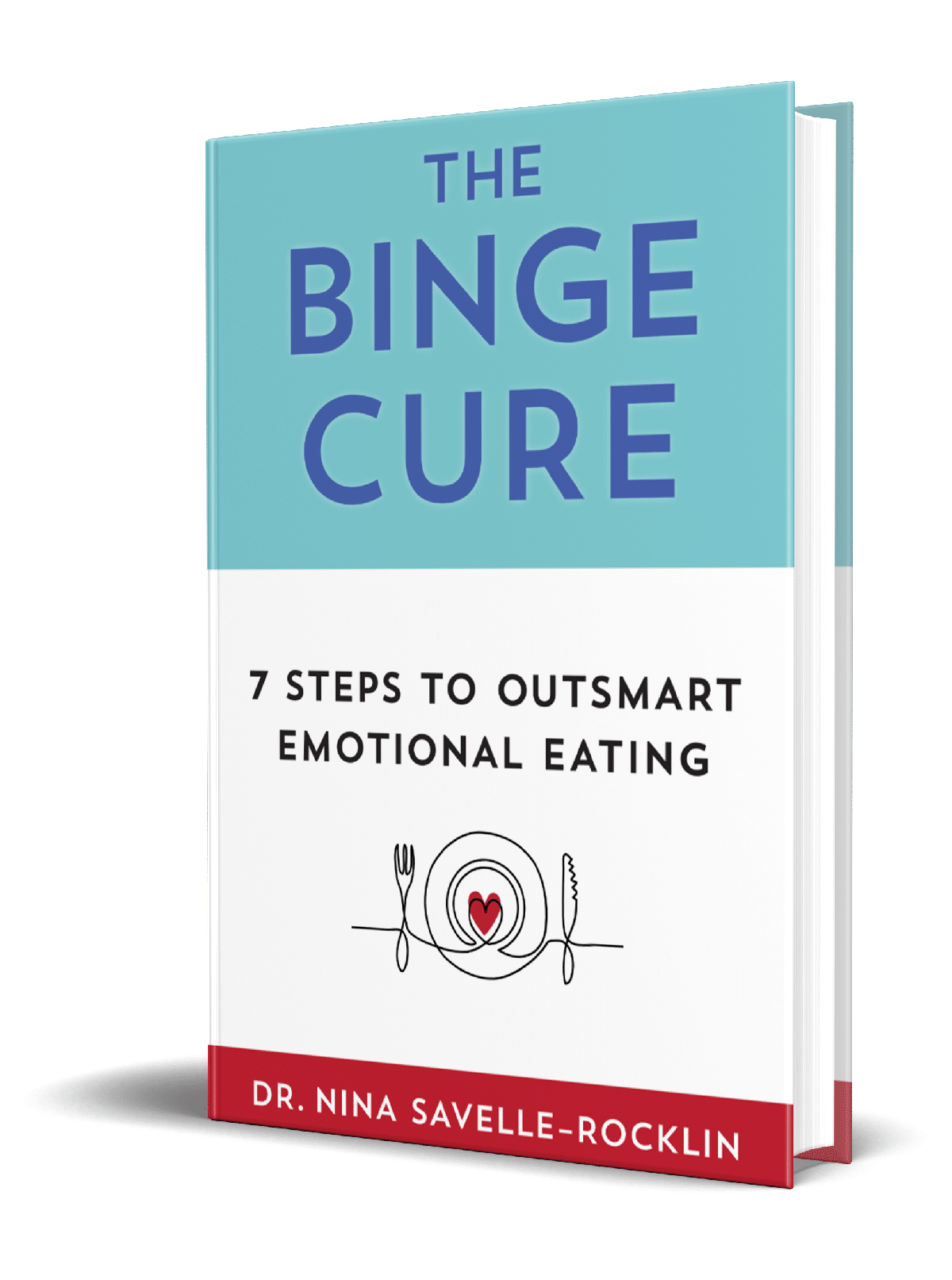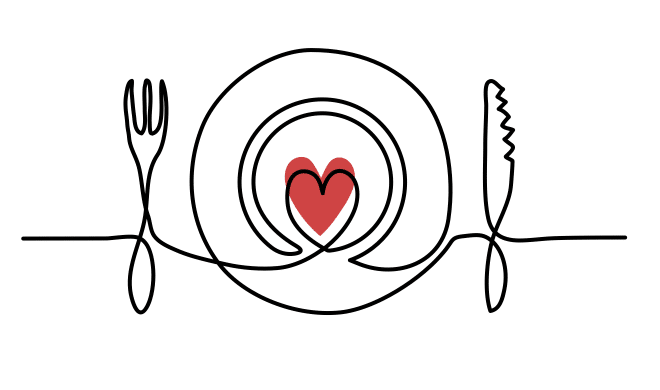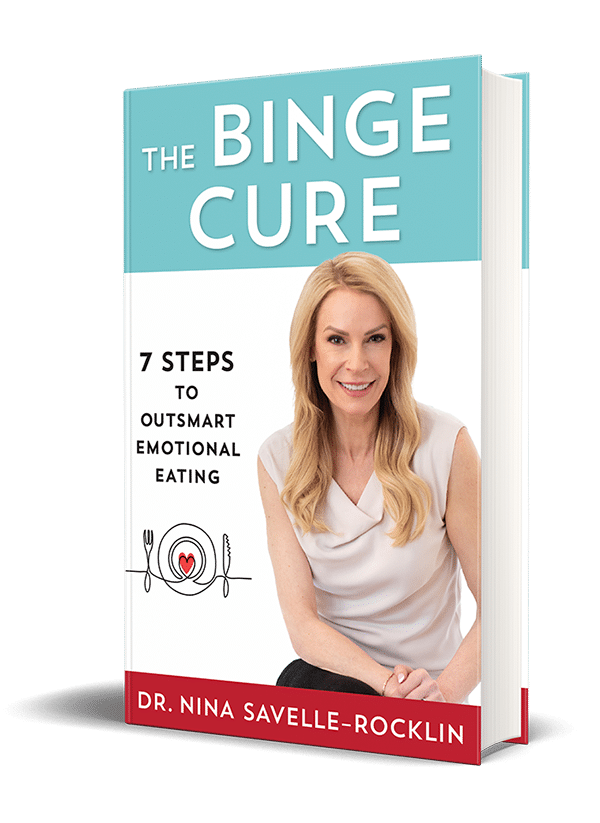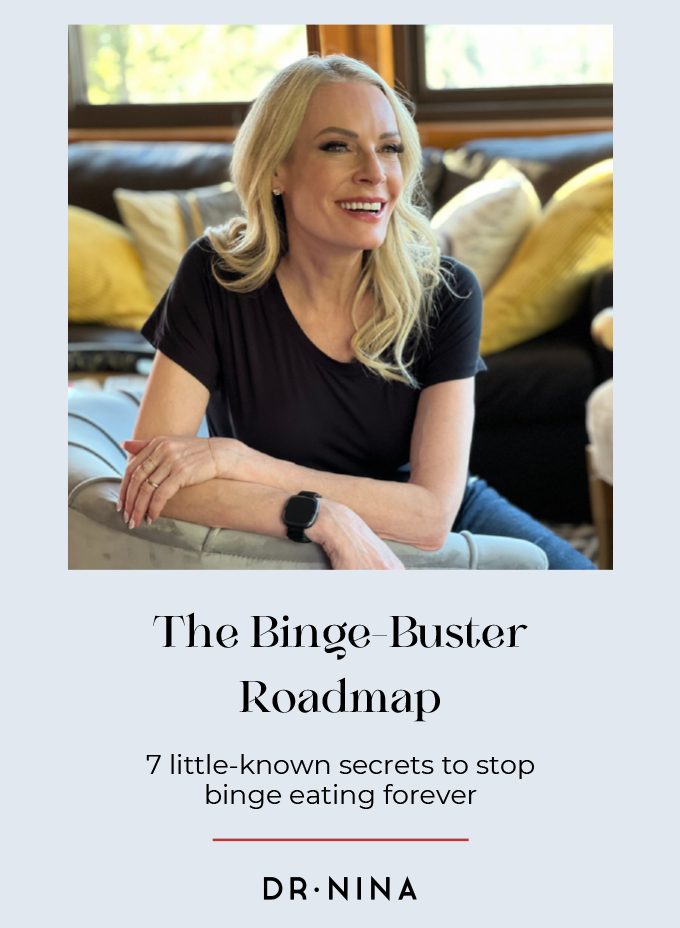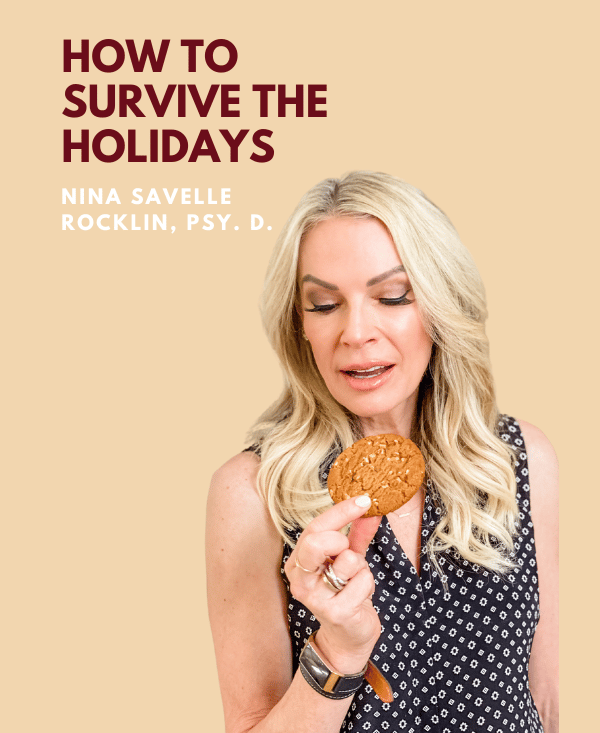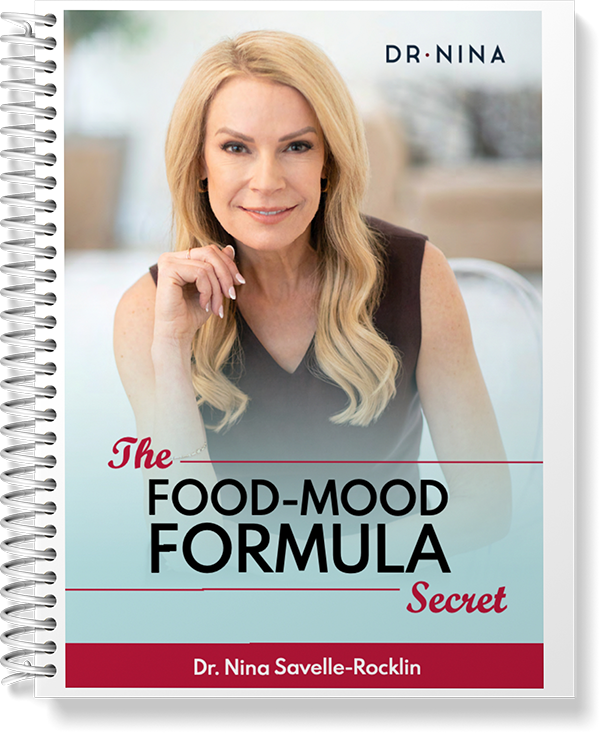Dr. Nina Savelle-Rocklin
From Trauma to Triumph: Understanding the Link Between Trauma and Binge Eating

Table of Contents
- The two types of trauma
- The legacy of trauma
- How trauma leads to binge eating
- What’s eating “at” you?
- How to convert your inner critic into a friend
- References:
Have you ever found yourself binge eating after a difficult experience? You're not alone. There is a strong connection between trauma and binge eating disorder.
Binge eating refers to eating a lot of food in a short amount of time and feeling like it’s impossible to stop. When it happens consistently it may be binge eating disorder which is a diagnosable and treatable condition.
Everyone has different reasons for why they binge eat, but usually, it's because they're trying to cope with difficult emotions. Often those emotions are unconscious, hidden out of awareness but not out of operation. Eating can make people feel better at the moment and temporarily help them forget about their problems.
Binge eating numbs difficult emotions and memories and provides a temporary sense of comfort. It’s a way of distracting from difficult feelings and experiences. Yet, this relief only lasts a little while, leaving us feeling even more shame and guilt.
Research has found that many people who struggle with binge eating also have a history of trauma. Studies have shown that around 50% of people struggling with binge eating disorder report a history of traumatic experiences, such as physical, emotional, or sexual abuse, neglect, or other adverse childhood experiences.
Of course, not everyone who struggles with binge eating has a history of trauma, and not everyone who experiences trauma will develop binge eating disorder. Binge eating disorder is a complex condition that can have multiple contributing factors, and each person’s experience is unique.
Trauma always causes a range of emotional responses, including feelings of shame, guilt, and low self-esteem. These emotions are overwhelming and difficult to process, leading to reliance on emotional eating to cope. This is true for both past and present traumas.
The two types of trauma
The idea of trauma is often misunderstood. Many people do not think they had a traumatic childhood and believe that others had it worse. It’s important to keep in mind that everyone's experiences and perceptions are valid and unique. It's not productive or helpful to compare traumas or minimize our own experiences.
Samantha* often found herself binge eating when she was feeling stressed or anxious. She brushed off the idea that this was a result of trauma, insisting she’d never experienced anything traumatic. “I basically had a normal childhood,” she said. “Nothing bad happened to me.”
She grew up in a household where her emotional needs were not met. Her parents were preoccupied with work and with their own problems, and they didn't provide enough of the emotional support and validation that Samantha needed as a child. She didn’t know that the emotional neglect she experienced was considered a form of trauma and had contributed to her binge eating behavior.
Like Samantha, many people think of trauma as an intense and severe event that significantly threatens people’s lives. Samantha thought trauma was an event such as war, a natural disaster, sexual or physical abuse, domestic violence, or the loss of a loved one.
That is one type of trauma, known as “Big T Trauma” which is also known as capital or complex trauma. Big T Traumas involve significant and severe threats to a person’s physical or psychological well-being. These experiences can have lasting effects on a person’s emotional health and functioning and can cause conditions such as Post-Traumatic Stress Disorder (PTSD), depression, anxiety, and other disorders.
A second type of trauma is called “little t” trauma and refers to experiences that may not be as severe or life-threatening but are still traumatic. Examples of “little t” trauma can include bullying, emotional neglect, chaos, financial instability, divorce or breakup, job loss, or chronic illness. These all negatively impact our sense of safety, security, and self-esteem.
Both types of trauma can have significant effects on mental and physical health. The emotional neglect that Samantha experienced had a lasting impact on her emotional health and behavior. Since she could not depend on her parents for consistent and available emotional support, she turned to food as a substitute for comfort and to fill the lonely void within. She never learned new ways of coping, and bingeing was her primary way of dealing with uncomfortable emotions.
Trauma can manifest in different ways and not all traumas are visible and obvious. Emotional neglect and verbal abuse may not be as visible as physical abuse or neglect, but still has a significant impact on our mental and emotional well-being.
The legacy of trauma
One legacy of trauma is that people feel bad about themselves, feel somehow flawed or defective, or not just good enough. Trauma shakes the foundation of our identity, leaving us feeling disconnected from ourselves and others, and unsure of ourselves. We may question our worth, value, and place in the world. It can leave us feeling powerless, helpless, and hopeless.
Trauma can also impact how we view others. It can create a distorted view of the world, leading to feelings of mistrust, fear, and anxiety. It can also impact our ability to create healthy attachments and relationships with others, leading to feelings of isolation and loneliness.
Trauma also has a profound impact on our sense of safety and security. Uncertainty and instability can make it difficult to trust others and build meaningful relationships. We may also feel as though they are constantly on guard or hypervigilant, as they try to anticipate and avoid potential threats.
This sense of unpredictability and unreliability in others is painful and overwhelming. Yet food is a constant in a world that feels chaotic and uncertain. Food is something that can be counted on to be there, day in and day out. Unlike people, food does not change or let us down.
For those who have experienced trauma, this predictability of food can be a source of comfort and stability. It provides a sense of reliability in a world that feels unreliable. Turning to food gives a sense of safety and comfort that we may not be able to find in our relationships with others.
Also, food is readily available. It can be purchased easily, no need for social interaction. This accessibility can be a relief for those who find social interactions challenging or overwhelming.
People who have experienced trauma often struggle with feelings of shame, guilt, and self-blame. They feel responsible for the trauma they experienced or ashamed for not being able to prevent it. This can lead to a negative self-image and a sense of worthlessness.
It is important to recognize that it is possible to heal and rebuild a positive self-identity. With support and treatment, we can learn to integrate our experiences with a more resilient and positive outlook on life. When that happens we don’t need food to cope.
How trauma leads to binge eating
Binge eating temporarily protects us from tough emotions. It’s a frenemy of sorts. It is a friend because it helps us by distracting from pain, providing comfort and soothing, and temporarily escaping discomfort. It is an enemy because it undermines our self-esteem and negatively impacts our emotional and physical health.
Seen this way, binge eating is not the true problem. It’s actually a solution to the real, underlying problem, which is usually some difficulty identifying, expressing, and processing difficult emotions. By tackling the root causes of binge eating, we can break free from destructive behaviors and achieve greater emotional well-being.
For Samantha, binge eating was a source of comfort and helped her manage feelings of emptiness or boredom. For others, food can be a way to distract themselves from uncomfortable thoughts and emotions, to pass the time, or to give themselves “me” time, providing a respite from caretaking and caregiving to others.
Focusing on food can also be a way of displacing powerlessness in some areas of life onto food. If you’re feeling powerless over a situation at work, for example, you may focus on having control over food instead.
Even though binge eating can make us feel better in the moment, it also makes us feel really bad afterwards. People feel guilty, ashamed, and disgusted with themselves. And over time, binge eating can lead to physical health problems like weight gain, diabetes, and heart disease, as well as depression and anxiety. That’s why addressing the underlying reasons for bingeing is essential.
What’s eating “at” you?
If you find yourself turning to food out of boredom or obsessing over every calorie, carb, or fat gram, it's important to recognize that there is likely an underlying reason for this behavior. While it may be difficult to pinpoint exactly what is triggering your behavior, it's important to understand that there is always something deeper going on internally.
By exploring these underlying emotions and addressing them directly, you can gain a greater understanding of your relationship with food and take the necessary steps towards improving your overall well-being.
Keeping a food-mood journal is a powerful tool for gaining insight into your eating habits and identifying patterns. Jot down what you ate, when and where, and dive deeper into your emotional state by recording your thoughts and feelings. This helps you connect the dots between your eating habits and your emotional well-being.In this journal, track the following:
When you ate: Record the time or day or night
What you ate: Jot down the type of food
Where you ate: Were you at home, at a restaurant, someone’s house, at a drive-through, in your car?
What you were thinking: Encourage self-awareness about your thoughts. What was on your mind?
How you were feeling: Mad, sad, glad, afraid, worried, anxious, hopeful, irritated, and so forth. Were you physically tired? What were you feeling?
By tracking what you eat, when you eat it, and how you're feeling before and after meals, you can begin to see connections between your emotions and your eating habits. This helps you recognize when you're using food as a coping mechanism to deal with difficult emotions or stressful situations, or to avoid thinking difficult thoughts.
How to convert your inner critic into a friend
Have you ever found yourself reaching for food when you feel overwhelmed by a loud inner voice? Maybe that voice tells you that you're not good enough, that you don't deserve happiness, or that you're a loser.
These negative thoughts can take a toll on your mental health and prevent you from living your best life. But what if there was a way to silence that mean voice and liberate yourself from its grasp?
One way to identify your inner critic is to listen when you talk to yourself in the second person. For example, when you say things like, “You're not good enough,” instead of “I'm not good enough.” By catching yourself in the act of negative self-talk, you can begin to recognize and challenge the harmful messages that your inner critic is feeding you.
Imagine your mind as a courtroom, with your inner prosecutor/critic on one side and an internal defense attorney on the other. When the prosecutor accuses you of not being good enough, you can object and demand evidence for these accusations. Remember, feelings are not facts and are not admissible as evidence.
Challenge the notion that there's something wrong with you or that you should be in a different place in your life. Give your inner defense attorney an equal opportunity to be heard.
Demand that the prosecutor define what “good enough” means. Is it your weight? What other criteria form the basis of this accusation? By presenting alternative evidence to the court, such as the fact that you're proactive, hopeful, and willing to consider new perspectives, you can challenge the negative beliefs that your inner critic has instilled in you.
Also, stop punishing yourself for crimes you haven't committed. You’re not “bad” because you ate ice cream, pizza, cookies, or whatever is on your forbidden foods list. And, you’re not “good” because you ate salad. Let’s change the conversation!
Liberating yourself from your inner prosecutor can help you feel better about yourself, reducing the urge to use food as a form of comfort or distraction or to restrict food to give yourself a sense of well-being. By silencing your inner critic and cultivating a more compassionate and supportive internal dialogue, you can create a more positive and fulfilling life for yourself.
Since trauma can take many forms and have long-lasting effects on our lives, it’s also beneficial to have a support system. That may include therapy and group support, since it’s incredibly helpful to connect with others who understand and can relate to you.
By acknowledging and working through the trauma that may be contributing to binge eating behavior, you can start to heal and find healthier ways to cope with difficult emotions.
Breaking free from binge eating by healing from trauma is a challenging and sometimes painful journey, but it is possible. Remember that you learned this way of relating to yourself, the world, and food, and you can learn a new way. Healing is a process, and it takes time and patience. Be kind to yourself, and don't give up. You are capable of overcoming your struggles and creating a brighter future for yourself. With persistence and dedication, you can achieve the peace and happiness that you deserve.
*All names have been changed
References:
Brewerton, T. D., Dansky, B. S., O'Neil, P. M., & Kilpatrick, D. G. (2016). A comparison of women with child-adolescent versus adult onset binge eating: Results from the National Women's Study. International Journal of Eating Disorders, 49(5), 469-475.
Brownstone, L. M., Bardone-Cone, A. M., Fitzsimmons-Craft, E. E., Printz, K. S., & Harney, M. B. (2017). Perceived parental invalidation exacerbates the effects of PTSD symptoms on disordered eating behaviors in women veterans. Eating Behaviors, 27, 59-63.
Grilo, C. M., Masheb, R. M., & Wilson, G. T. (2001). Subsyndromal binge eating disorder. International Journal of Eating Disorders, 30(2), 129-138.
Scharff, A., Becker, A. E., & Smith, L. M. (2011). Trauma history characteristics associated with binge eating and weight in a community sample of women. Comprehensive Psychiatry, 52(6), 712-716.
Selby, E. A., Smith, A. R., Bulik, C. M., Olmsted, M. P., Thornton, L., McFarlane, T. L., … & Crosby, R. D. (2010). Habituation of reward response is correspondingly decreased in women with bulimia nervosa and binge eating disorder. Biological Psychiatry, 68(8), 704-708.
Tagay S, Schlottbohm E, Reyes-Rodriguez ML, Repic N, Senf W. Eating disorders, trauma, PTSD, and psychosocial resources. Eat Disord. 2014;22(1):33-49. doi: 10.1080/10640266.2014.857517. PMID: 24365526; PMCID: PMC3966425.
Wonderlich, S. A., Crosby, R. D., Engel, S. G., Mitchell, J. E., & Smyth, J. (2007). Childhood trauma and bulimia nervosa: Comparison of personality and behavioral characteristics in bulimia nervosa with and without a history of abuse. International Journal of Eating Disorders, 40(6), 505-510.
Wonderlich, S. A., Gordon, K. H., Mitchell, J. E., Crosby, R. D., Engel, S. G., Masheb, R. M., & Peterson, C. B. (2009). The validity and clinical utility of binge eating disorder. International Journal of Eating Disorders, 42(8), 687-705.
Zandberg, L. J., & Mitchell, J. E. (2016). Psychological treatments for binge eating disorder. Current Opinion in Psychiatry, 29(6), 426-431.
Sick of obsessing about every bite?
GET THE CURE
The Binge Cure Book!
Enter “CURE” to receive a 20% discount.
No, I don’t want access to this terrific resource to help me overcome binge eating.
The Author

Dr. Nina Savelle-Rocklin is a renowned author and podcast host and one of the nation’s leading psychoanalysts known for the psychology of eating. Her signature message of, “It’s not what you’re eating, it’s what’s eating ‘at’ you” has resonated with hundreds of thousands of listeners from around the globe in 40 countries. As founder of The Binge Cure Method, she guides emotional eaters to create lasting food freedom so they can take back control of their lives and feel good in their bodies.
Related Blogs

